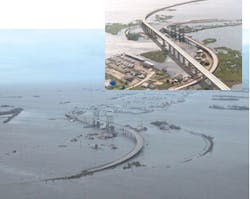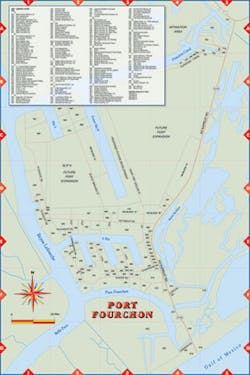LA 1 Coalition established to improve highway transport to Port Fourchon
David Paganie, Senior Editor
As the only land route linking Port Fourchon in southern Louisiana with the rest of the state, Louisiana Highway 1 (LA 1) performs a number of vital functions. The two-lane highway is a primary transportation route for domestic oil and gas support services and supplies, as well as for imported oil offloaded from ships in the GoM.
The highway also serves as a hurricane evacuation route for a local population of 35,000 residents and 6,000 offshore workers. The most critical and flood-prone segment of LA 1 is the 17-mi stretch between Golden Meadow and Fourchon, which crosses wetlands, bayous, channels, and flood plains. According to the LA 1 Coalition, this segment of road is actually “sinking.”
To alleviate future obstructions along this route, the Louisiana Department of Transportation and Development (DOTD), in cooperation with the Federal Highway Administration, has proposed the construction of new infrastructure from Raceland at US 90 to Fourchon. Established in 1997, the LA 1 Coalition is leading this effort.
The new route, 47 mi of new highway from US 90 to Port Fourchon and Grand Isle, is estimated to cost $1 billion. Funds are to come from a variety of sources, including bonds, federal loans, federal and state equity, the NOAA, state capital outlay, the Greater Lafourche Port Commission, and private contributions.
Funds from OCS revenue-sharing are currently not available. As a result of insufficient cash, users will pay for portions of the improvements. “Tolling the road is the only way we can finance the project, unless other sources become available, including offshore revenue sharing, where we now feel we have some leverage, because of the damage from Hurricane Katrina,” says Ted Falgout, executive director of Port Fourchon.
According to the Coalition, in 2005, total revenue collected by the MMS from the OCS was $5.7 billion. Offshore Louisiana leases were the source of 74.2% of that amount. The state of Louisiana received only $32 million from revenue sharing on federal lands (less than 1% of the total generated off the state’s coast). Furthermore, Louisiana receives no revenue sharing from OCS activity outside of 6 mi.
Nonetheless, the project is proceeding. In January, the DOTD accepted a bid of $141 million by Massman Construction/Traylor Brothers Joint Venture for Phase 2B.•



